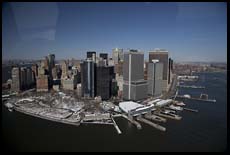
The Greatest Trade Ever
reviewed by Philip Greenspun; April 2010
Site Home : Book Reviews : One Review

|
The Greatest Trade Everreviewed by Philip Greenspun; April 2010
Site Home : Book Reviews : One Review |
This is a summary/review of
The Greatest Trade Ever: The Behind-the-Scenes Story of How John Paulson Defied Wall Street and Made Financial History
by Gregory Zuckerman, a Wall Street Journal reporter.
Do we really need to hear another retelling of the events that led to the collapse that may have dimmed the career prospects of an entire generation of Americans? For the sake of America's young people, I think the answer is "yes".
Zuckerman's explanation of the events that led up to the Collapse of 2008-? starts with the September 11 attacks on the World Trade Center and Washington, D.C. The Federal Reserve Bank, anxious to prevent a recession, set real interest rates at historic lows (1 percent nominal in mid-2003, which meant a negative real interest rate for a bank). This created the germ of the housing bubble. The bubble's growth was sustained by Wall Street's compensation structure, in which employees were able to earn billions of dollars in take-home pay by exposing their shareholders to trillions of dollars in risk. Contributing factors were conflicts of interest at rating agencies such as Moody's and S&P. Everyone on Wall Street enjoyed wonderful annual paydays while investors were exposed to risks that ensured that they'd be wiped out eventually.
The principal characters in the book's drama are the following:
Houses are a bit cheaper than they were in 2005-2006. Does that mean
they are good values? the book suggests that the answer is "no".
In 2005, "24 percent of all mortgages were done without any down payments at all, up from 3 percent in 2001. More than 40 percent of loans had limited documentation, up from 27 percent. A full 12 percent of mortgages had no down payments and limited documentation." Basically the housing prices of the mid-2000s were entirely a result of the fact that banks were paying people with poor credit to buy and live in houses. This was a rational decision for a lot of Americans, who got to live rent-free for several years in exchange for a trashed credit rating. It was a rational decision for employees at mortgage companies and banks, who enjoyed fat bonuses based on fake profits. But it meant that house prices were driven up to irrational levels and that, eventually, investors would be wiped out.
Pellegrini's analysis was that "housing prices had climbed a puny 1.4 percent annually between 1975 and 2000, after inflation was taken into consideration. But they had soared over 7 percent [per year] in the following five years, until 2005. The upshot: U.S. home prices would have to drop by almost 40 percent to return to their historic trend line. Not only had prices climbed like never before, but Pellegrini's figures showed that each time housing had dropped in the past, it fell through the trend line, suggesting that an eventual drop likely would be brutal."
[U.S. house prices have not fallen, on average, by the required 40 percent since 2005 (this chart shows that prices are about the same as in 2005). Therefore we may continue to see years of government using taxpayer money to prop up U.S. house prices (the current $8,000 tax credit is about 4% of the price of the average house). Given the 1.4 percent appreciation rate, according to Pellegrini, it will be 2030 before houses are naturally valued at their 2005/2010 price (in real dollars). If we assume 2 percent annual inflation, it will be 2015 before houses are naturally valued at their 2005/2010 price in nominal dollars.]

How did the smartest people in the world fail to see the impending collapse of subprime? Lahde in his farewell letter attributes their failure to stupidity and a lifetime of privilege. Paulson and Pellegrini, however, attributed the failure to Wall Street's numbers geniuses using data based on 20-percent down mortgages and 60 years of rising prices to analyze the probability of defaults on 0-percent down mortgages in a world where prices were certain to flatten. The brightest minds on Wall Street did not adjust for the reality that a huge number of people buying houses in the U.S. were never in a position to pay for that house. They had a no-money-down mortgage for $X, the entire value of the house (and sometimes 25 percent more!). They had a deal where they could pay perhaps half of the interest due for a couple of years, by which time the house was expected to be worth $1.2X. The house would be refinanced and the "homeowner" would pull some cash out for living expenses plus be able to make some low teaser payments for two years by which time the house would be refinanced again at its new higher value of $1.5X. Wall Street did not consider what would happen if house prices merely stayed the same for a couple of years.
The data were available. In states where house prices were flat, default rates were much higher than in states that continued to boom. But people on Wall Street did not bother to look, which resulted in a massive mispricing of risk on mortgage-backed securities.
Zuckerman notes that "In January 2007, Stanley O'Neal and Merrill Lynch proudly unveiled an agreement to pay $1.3 billion to buy First Franklin Financial [a subprime lender] ... Merrill now had more than $11 billion of [subprime loans], even though the firm's own economists predicted a decline in housing prices of up to 5 percent." Wall Street executives did not see the connection between flat prices and high default rates.
According to this book, Paulson was indirectly responsible for the collapse of Bear Stearns. Samual Molinaro, Jr., the chief operating and financial officer of Bear, hosted a lunch for hedge fund managers to try to woo them back to the company, which was perceived as weak. Everything was going well until Paulson asked Molinaro how many risky and hard-to-price assets Bear had. Molinaro had no idea, so Paulson said, in front of 20 other hedge fund managers, "I'll tell you what the number is. It's $220 billion. ... if you have $14 billion in equity and $220 billion of [risky] assets, a small movement in the assets can wipe out your equity completely." This started a run on Bear Stearns, with hedge funds pulling out billions. A month later, Bear Stearns was sold to J.P. Morgan for pennies on the dollar.
A failure to protect shareholders' interests did not get in the way of compensation, Zuckerman notes. Stan O'Neal was paid $70 million for the four years that he spent bankrupting Merrill and then another $161 million when he was fired. Chuck Prince, who bankrupted Citigroup, was paid $110 million in severance, plus an office, assistant, car, and driver. [These firms still exist, of course, because they were stuffed full of taxpayer dollars to make up for the ones that executives took home or squandered (see It Takes a Pillage).]

The book suffers from sample bias. We're reading about the guys who got rich from shorting mortgages in 2005 and 2006. What about the guys who shorted mortgages at the same time, but were forced to give up early because they couldn't take the pain? What about the guys who shorted mortgages even earlier? Zuckerman writes about William Ackman, a hedge fund manager who started to bet against the fraud-riven subprime mortgage industry in 2002 and, apparently, had to close out the trade with a substantial loss in 2007.
Michael Burry was much earlier than Paulson and had to fight off bitterness and ridicule for years, nearly wrecking his sanity. He finally made quite a bit of money for investors and himself, but the experience was mostly a sour one. Paulson in a sense was fortunate that he did not turn his attention to mortgages until relatively late in the boom.
Jeffrey Greene owned $500 million in Southern California real estate and was getting nervous about its value. He was an old friend of Paulson's and, in 2006, let Paulson pitch him on the virtues of investing in his new fund to bet against mortgages. Instead of agreeing to pay the 2-and-20 fee (2 percent annually raked off the top regardless of performance, plus 20 percent of any profits), Greene decided that he could run the trade himself. He pestered his Merrill Lynch broker until the guy got approval from top executives to allow a rich individual to participate in the illiquid and confusing credit default swap market.
Greene made some missteps. He bought insurance on subprime mortgages that were issued in the early 2000s. The houses had appreciated enough by 2006 that the owners could surely refinance them. Paulson and Pellegrini made the same mistakes, but could recover from them with less psychic trauma because it was other peoples' money. Greene was faced with margin calls and nervously calling his broker every day to check prices on the credit default swaps. Greene would rage that he couldn't understand why his CDS positions weren't appreciating given that house prices were falling and lenders were failing.
Greene had trouble selling his positions because Wall Street did not want to recognize how much they were worth. If they admitted that Greene was worth $500 million they'd have to revalue the CDOs and mortgage-backed securities on their books to an extent that would enable anyone to see that they were insolvent. Greene was finally able to cash out only because Merrill panicked and, in a last ditch effort to save the firm, tried to unwind its exposure to subprime via any means possible.

Zuckerman cites "A 2006 survey of almost three hundred hedge-fund professionals found that they on average had spent $376,000 on jewelry, $271,000 on watches, and $124,000 on 'traditional' spa services over the previous twelve months."
$271,000 on watches. Per person. On average. For 300 people. Each of whom has at most two wrists.
The last pages of the book describe what Paulson did after shorting mortgages. He realized that the bad mortgages would bring down banks in the U.S. and the U.K., so he shorted them either directly or with credit default swaps. Then in the spring of 2009 he began buying up about $20 billion of disfavored assets, such as junk bonds, mortgage-backed securities, and financial industry shares (these went even lower than common stocks and bounced back quite nicely). So the guy is 3 for 3. What's he doing now?
Paulson made a simple calculation: The supply of dollars had expanded by 120 percent over several months. That surely would lead to a drop in its value, and an eventual surge in inflation. .. "With all of this spending, we're going to have massive inflation," Paulson told Hoine [a colleague], arguing that almost every major currency was at risk, other than the Chinese yuan.
Paulson has been moving his personal and client assets into gold and gold mining firms. "Betting against the dollar would be his new trade."
The Greatest Trade Ever
is an important book for understanding the mechanics of trading credit
default swaps. It is also a good review of the looting out of the
U.S. economy during the 2000s.
The book provides good insight into why it is so hard to figure out whether or not a financial institution is sound. Most of their investments are now in things that aren't publicly traded and therefore cannot be priced until they are actually sold. Even as their accountants are declaring profits and employees are paying themselves $50 million bonuses, the firm may be insolvent.
One flaw in the book is that it presents many of the main characters as near-clairvoyants. They knew what to do, but investors and supervisors did not give them the chance so they ended up struggling for years before becoming incredibly successful. The narrative proceeds logically from childhood through billionairehood. Zuckerman never considers an alternative hypothesis: professional money managers get to experiment with other peoples' money every year; if a trade doesn't work they don't get rich or famous that year, but they live to try something else next year; Paulson and Pellegrini had been on Wall Street for about 25 years and had never had a big success until this one; this shows that flipping a heavily biased coin 25 times still results in a pretty good chance of coming up heads. The fact that Paulson stuck to the trade when everyone was urging him to lock in some profits is compelling, but with thousands upon thousands of money managers in the U.S., it is inevitable that a writer could find a handful who were consistently right over a 5- or 10-year period.
This book contains no figures, graphs, photos, or other illustrations. As such it would be fine for reading on a Kindle or similar electronic reader.